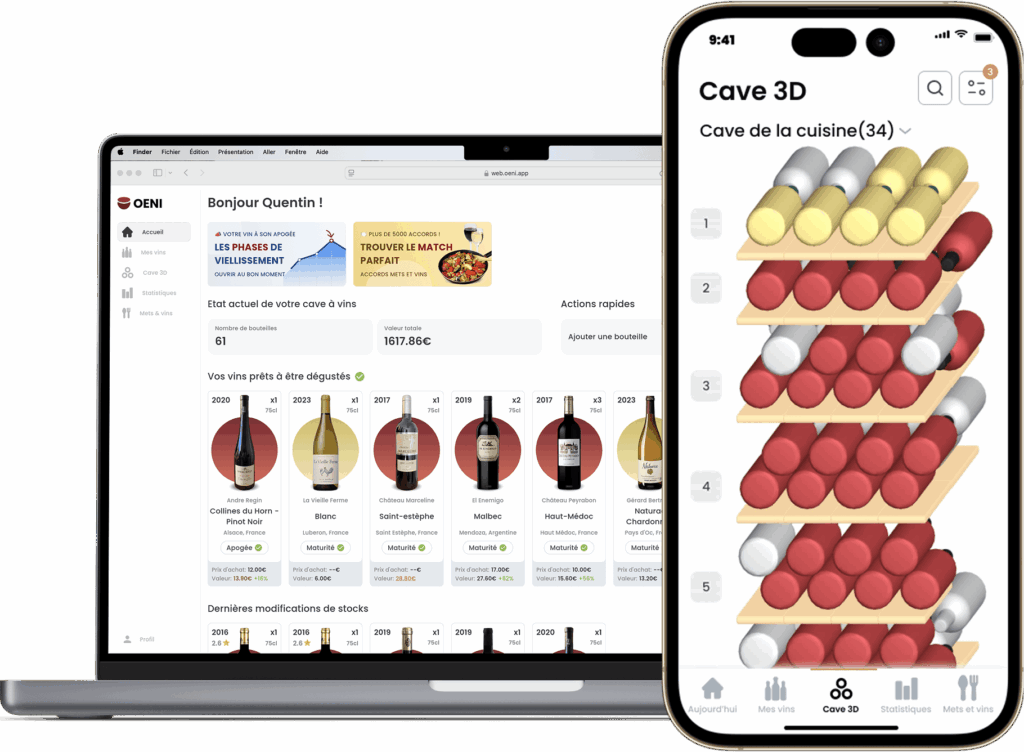Between growing passions and impulse purchases, a wine cellar fills up fast. However, without a clear method, chaos can set in. It's difficult to know where each bottle is, or which wine is reaching maturity.
If you're interested in wine-related articles, download our app for IOS or Android. It will give you access to our wine lexicon, our articles and our innovative solution, designed for all wine consumers and collectors.
Understanding the importance of organizing your wine cellar
A well-organized cellar simplifies your choices when uncorking a bottle. It also helps avoid unpleasant surprises. A badly stored or forgotten wine can lose all its interest. So you need to think ahead.
What's more, knowing what's in your cellar prevents duplication and unnecessary purchases. It also allows you to adapt your purchases according to recent tastings. Rigorous wine bottle management gives you a clearer picture of your stock and needs.
Choosing the right sorting method
There are several ways to classify your bottles. It all depends on the size of your cellar, but also on your consumption habits.
By wine region: ideal for fans of specific terroirs.
By color: red, white, rosé, sparkling... More visual identification.
By vintage: useful for planning openings at the right time.
By estimated peak: to avoid missing the best tasting period.
You can also combine several criteria. For example, group reds by region, then classify them by vintage. This method optimizes personal cellar sorting while maintaining a clear logic.
Use clearly identified racks or shelves
Once the criteria have been chosen, it's time to put them into practice. Numbered racks, labels or color codes can make all the difference.
Each zone must correspond to a well-defined category. This allows you to find a specific bottle quickly, without disturbing others. By noting locations on a map or app, errors are minimized. A good wine cellar organizer is based on a simple, reproducible structure.
Record entries and exits systematically
Every bottle addition deserves a record. The best way to do this is to keep an up-to-date register, or use a software program. This prevents you from losing track as your cellar grows.
For each wine, we can note :
The estate and the cuvée
The vintage
Purchase price
Cellar entry date
The estimated apogee
Best before date
The feeling after tasting
This method allows you to adopt a complete and useful bottle management approach over time. What's more, it helps you refine your tastes over time.
A dedicated area for quick-drinking wines
Not all wines are made to age. Some need to be drunk young. So it's a good idea to reserve a corner of the cellar for these bottles.
This clearly identified area prevents the mixing of mature and older bottles. This personal cellar sorting ensures consistent rotation. No bottle is ever left at the bottom of a rack.
Integrate a specialized application for optimal management

Many mobile applications make it easy to manage your wine cellar. Some are free, while others require a subscription.
These tools often offer :
A label scan
A global database
Tasting history
Maturity alerts
A map of the cellar
Combining a physical plan with a digital tool saves time and improves clarity. This reinforces intelligent, sustainable wine bottle management.
Adapting your organization to the evolution of your winery
A cellar is never static. New purchases enrich the collection. The layout must therefore be adjusted regularly.
Every 3 to 6 months, it is advisable to :
Check inventory
Reassessing apogees
Tasting ready-made bottles
Free up space if needed
This follow-up avoids clutter and preserves the balance of the cellar. It's also a good time to reclassify or review criteria.
Anticipate peak consumption periods
End-of-year parties, grand tablées and weddings call for forward planning. It is useful to identify in advance the wines to be served.
Some bottles can then be moved to an easier access point. This anticipation saves time. It also avoids opening a grand cru by mistake.
Securing the cellar to avoid mistakes or losses
If several people have access to the cellar, a clear storage code is essential. Laminated labels or a notebook visible in the room are a good start.
It's also important to check storage conditions regularly. Temperature, humidity, absence of light and vibration are crucial.
Thinking about passing on or sharing the cellar
A well-organized cellar facilitates exchanges between wine enthusiasts. It also enables you to pass on your bottles in the best possible conditions. A clear register or a shared app provides global visibility.
In this way, an heir or friend can take over without getting lost. Precise organization ensures harmonious continuity.
Reserve a space for your favorites and discoveries
Finally, every enthusiast likes to discover new bottles. So it's a good idea to set aside an area for testing. These wines can then be integrated into the overall structure or consumed quickly.
This dedicated area avoids disrupting the entire cellar. It makes organization more fluid and evolutionary. It enhances the pleasure of collecting, without sacrificing the established order.
If you enjoyed this article, please read the following article "How to configure ripeness alerts in Oeni to avoid "past" wines", which might also be of interest to you!





